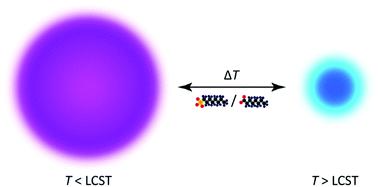当前位置:
X-MOL 学术
›
Soft Matter
›
论文详情
Our official English website, www.x-mol.net, welcomes your feedback! (Note: you will need to create a separate account there.)
Assessing the perfluoroalkyl acid-induced swelling of Förster resonance energy transfer-capable poly(N-isopropylacrylamide) microgels
Soft Matter ( IF 2.9 ) Pub Date : 2021-10-04 , DOI: 10.1039/d1sm00985k Dustin T Savage 1 , J Zach Hilt 1 , Thomas D Dziubla 1
Soft Matter ( IF 2.9 ) Pub Date : 2021-10-04 , DOI: 10.1039/d1sm00985k Dustin T Savage 1 , J Zach Hilt 1 , Thomas D Dziubla 1
Affiliation

|
As a method to combat the extensive contamination of poly- and perfluoroalkyl substances (PFAS) in water supplies, poly(N-isopropylacrylamide) (PNIPAM) microgels copolymerized with 2,2,2-trifluoroethylacrylate (TFEA) represent a potential sensing tool for recognizing PFAS at dilute aqueous concentrations. The microgels exhibit exceptional temperature responsiveness, transitioning from a swollen z-average diameter of 890.8 ± 19.8 nm to a collapsed diameter of 246.4 ± 10.3 nm below and above their lower critical solution temperature, respectively, for non-fluorinated gels, offering broad size fluctuations that are susceptible to coadded contaminants. Monitoring size perturbations as a function of analyte concentration, the polymers were observed to deswell in the presence of perfluorooctanoic acid, octanoic acid, phenol, and sodium 1-octane sulfonate while tetraethylammonium perfluorooctane sulfonate (TPFOS) augmented swelling. Adding up to 40 mol% TFEA to the networks lowered the concentration at which the microgels’ normalized z-average diameter demonstrated a significant deviation from 0.25 mM to 0.1 mM for TPFOS, indicating fluorophilicity as a key contributor to the copolymers’ associative capacity. Implanting Förster resonance energy transfer-compatible dyes, cyanine 3 and cyanine 5, into non-fluorinated microgels largely reiterated results from light scattering, as expected for the size-dependent energy transfer mechanism. Including dyes did, however, reinforce the customizability of this system, leaving windows open for functionalization with other signal transduction motifs to lower the detection limits of the polymer further. The swelling changes for PNIPAM microgels stimulated by the acidic constituents of PFAS highlight the polymer as a candidate for detecting the substances following additional development.
中文翻译:

评估 Förster 共振能量转移能力聚 (N-异丙基丙烯酰胺) 微凝胶的全氟烷基酸引起的膨胀
作为一种对抗供水中多氟烷基物质和全氟烷基物质 (PFAS) 广泛污染的方法,与 2,2,2-三氟乙基丙烯酸酯 (TFEA) 共聚的聚 ( N-异丙基丙烯酰胺) (PNIPAM) 微凝胶代表了一种潜在的传感工具,用于识别PFAS 在稀水浓度下。微凝胶表现出卓越的温度响应性,从膨胀的z- 对于非氟化凝胶,平均直径为 890.8 ± 19.8 nm,收缩直径为 246.4 ± 10.3 nm,分别低于和高于其较低的临界溶液温度,提供了容易受到共添加污染物影响的广泛尺寸波动。监测作为分析物浓度函数的尺寸扰动,观察到聚合物在全氟辛酸、辛酸、苯酚和 1-辛烷磺酸钠的存在下消溶胀,而全氟辛烷磺酸四乙基铵 (TPFOS) 增强了溶胀。向网络中添加高达 40 mol% 的 TFEA 降低了微凝胶标准化z的浓度-TPFOS 的平均直径显示出从 0.25 mM 到 0.1 mM 的显着偏差,表明亲氟性是共聚物缔合能力的关键因素。将与 Förster 共振能量转移相容的染料花青 3 和花青 5 植入非氟化微凝胶中,很大程度上重申了光散射的结果,正如尺寸依赖性能量转移机制所预期的那样。然而,包括染料确实增强了该系统的可定制性,为其他信号转导基序的功能化打开了窗口,以进一步降低聚合物的检测限。由 PFAS 的酸性成分刺激的 PNIPAM 微凝胶的溶胀变化突出了聚合物作为在进一步开发后检测物质的候选者。
更新日期:2021-10-19
中文翻译:

评估 Förster 共振能量转移能力聚 (N-异丙基丙烯酰胺) 微凝胶的全氟烷基酸引起的膨胀
作为一种对抗供水中多氟烷基物质和全氟烷基物质 (PFAS) 广泛污染的方法,与 2,2,2-三氟乙基丙烯酸酯 (TFEA) 共聚的聚 ( N-异丙基丙烯酰胺) (PNIPAM) 微凝胶代表了一种潜在的传感工具,用于识别PFAS 在稀水浓度下。微凝胶表现出卓越的温度响应性,从膨胀的z- 对于非氟化凝胶,平均直径为 890.8 ± 19.8 nm,收缩直径为 246.4 ± 10.3 nm,分别低于和高于其较低的临界溶液温度,提供了容易受到共添加污染物影响的广泛尺寸波动。监测作为分析物浓度函数的尺寸扰动,观察到聚合物在全氟辛酸、辛酸、苯酚和 1-辛烷磺酸钠的存在下消溶胀,而全氟辛烷磺酸四乙基铵 (TPFOS) 增强了溶胀。向网络中添加高达 40 mol% 的 TFEA 降低了微凝胶标准化z的浓度-TPFOS 的平均直径显示出从 0.25 mM 到 0.1 mM 的显着偏差,表明亲氟性是共聚物缔合能力的关键因素。将与 Förster 共振能量转移相容的染料花青 3 和花青 5 植入非氟化微凝胶中,很大程度上重申了光散射的结果,正如尺寸依赖性能量转移机制所预期的那样。然而,包括染料确实增强了该系统的可定制性,为其他信号转导基序的功能化打开了窗口,以进一步降低聚合物的检测限。由 PFAS 的酸性成分刺激的 PNIPAM 微凝胶的溶胀变化突出了聚合物作为在进一步开发后检测物质的候选者。












































 京公网安备 11010802027423号
京公网安备 11010802027423号